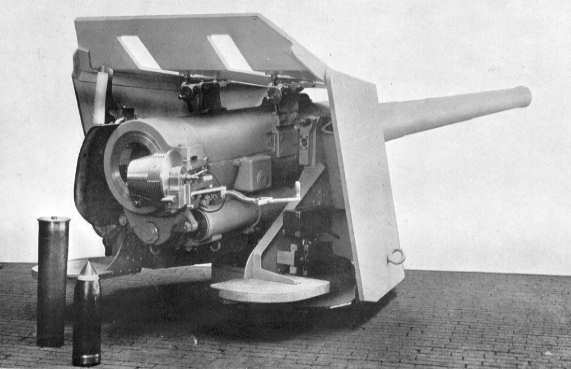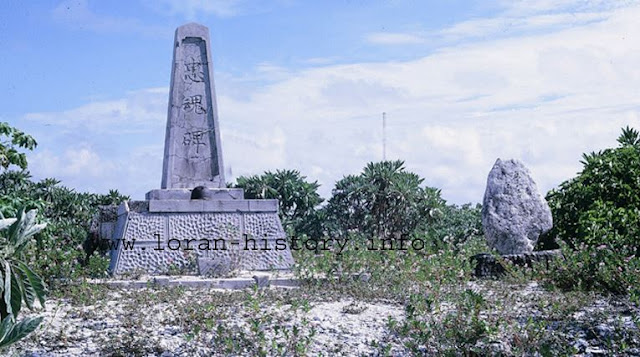Remains of Japanese Defenses on Marcus Island
"The Island was an impregnable fortress, impervious to bombing damage with reinforced concrete bunkers... an underground fortress, laced with tunnels connecting to secret facilities... All of the people and technology was underground....in a mountain larger than the Island itself." - Douglas Dietrich
Note: Marcus Island defenses also included a number of 6-inch Naval guns and Type 95 (Ha-Go) Light Tanks. [5]
A number of these tanks were dug into permanent concrete positions or placed individually at points around the Island.
The Type 41 6-inch (150 mm) gun fired a 100-pound (45.4 kg) shell with either an armor-piercing, high explosive, or general-purpose warhead. An anti-submarine shell of 113-pound (51.3 kg) was developed and in service from 1943.
https://en.wikipedia.org/wiki/QF_6-inch_naval_gun#Japanese_naval_service
 |
| Type 41 6-inch (150 mm) gun |
 |
| Type 95 Tank in concreted position |
An intricate series of trenches connected to pillboxes, rifle pits, and blockhouses surrounded the entire shore of the Island with concreted defensive positions on all three corners.
Most numerous, however, were the anti-aircraft positions. I have designated the "Heavy" anti-aircraft guns in red (above) as shown on US Navy maps. There were also a similar number of "light" anti-aircraft positions scattered at various points around the Island.
 |
| 25mm Light Anti-aircraft gun |
 |
| Type-3 5- inch (12 cm) Heavy AA gun |
I have shown the heaviest concrete defenses in grey (above).
I have reviewed almost a dozen US Navy maps from 1942-45. Both the targeting and battle damage assessment maps of the Island in 1942-43 indicate very specifically that these were above ground.
In fact, the maps showed detailed locations of concrete personnel barracks, administrative buildings, earth-covered buildings, fuel, oil, and ammunition storage sites, bomb shelters, aircraft hangars, radio transmission sites, radar sites, and several large concrete "bunkers" used for dry storage (some of which were not targeted).
May 19-20, 1944
(USN) Third Raid on Marcus - Planes from a three-carrier task force under the command of Rear Admiral A. E. Montgomery hit Marcus with a predawn fighter sweep and strafed and bombed the island for two consecutive days.
Anyone who pays close attention to the photographs taken of the Island during and shortly after the war will notice that by 1945 the Island was devoid of any vegetation and very few structures above ground remained. The runways had been destroyed with no attempt to rebuild.
There is no evidence whatsoever to substantiate the claim that the Japanese had created any subsurface structures into or under the Island itself. Were it not for a continued effort to re-supply the garrison on Marcus Island, it is quite possible they would have starved to death. The conditions encountered by US Occupation Forces on the Island in August 1945 were desperate, with the majority suffering from severe malnutrition and disease.
According to a March 10, 1946, Owensboro, Messenger (KY) article titled: "Marcus Island, Old Jap Outpost, Was Heavily Fortified Against Invasion"
"It was used as a weather and radio station and a base for staging aircraft to other Japanese possessions in the Central Pacific."
"...Over 500 Japanese had been killed by bombs and another 500 had died of starvation, and the gaunt survivors were eating weeds, birds, and a few squash pumpkins which they had managed to grow in gardens. Only one tree remained standing."
"Navy Captain A.E. Loomis, the Islands Commander, said that when US forces occupied Marcus, they found about 6o Japanese trucks and a dozen tanks still intact. They were quickly turned into junk by a series of races staged by Marines and Seabees. The wrecked equipment was then bulldozed into a long wide trench and buried."
To say that there were no civilians on the island during WW2 is also untrue. Although a smaller number remained in August 1945 at the time of the Japanese surrender, there had been hundreds of Japanese civilian laborers on the Island throughout the war.
Unlike the many other Pacific Islands invaded by the US in WW2, Minami-Tori-shima posed no significant threat, in fact, it was decided to simply bypass and isolate the remote Island and suppress its sustainability with a continued bombing effort.
A very similar situation existed involving Wake Island.
"The surrender of Marcus found 1763 Army and 779 Navy personnel remaining-the majority ill and emaciated-even though 300 moderately sick cases had been permitted to depart two days previously in a demilitarized Japanese APD which had been allowed to bring in food for the starvation-threatened garrison and instructed to remove as many of the sick as could be returned to Japan.
There were also 204 civilians on Marcus, including 15 Koreans. Because of inadequate facilities for their reception and treatment, the Japanese APD had not attempted to remove the worst hospital cases, but had, instead, left them for future evacuation by a hospital ship." [5]
"In 1947 the high tide caused by a typhoon washed away a large section of the (Southwest portion of) the island. For this reason, the U.S. Army that was stationed there withdrew from the island, and Marcus Island became once again an uninhabited place." [3]
April 30 to May 6, 1952 – Report by Mr. Sakagami of the Zoological Institute, Faculty of Science, Hokkaido University, Sapporo, Japan. He made the following comments in his report on Marcus Island, published in 1961 by Pacific Science:
“Now being totally disfigured, Marcus Island, which lies peacefully and beautifully with a green cover and white beach surrounded by deep-colored semitropical ocean, impressed us as a disappointment as soon as we landed on it. Everywhere on the island are to be found residues of war. All along the coast are trenches, with tochkas here and there on which rusted anti-aircraft guns are still pointing to the sky. On the northern coast, from the eastern end to the western, a broad runway was constructed for occasional visits of airplanes, and almost all the southwesterly one-third of the island is gone as it was devastated by the typhoon, the ruins of United States camps and trucks scattered everywhere." [5]
 |
| Type 95 Tank |
 |
| Type 95 Tanks for inspection at surrender August 1945 |
 |
| Remains of Type 95 Tank |
| Remains of Naval gun |
 |
| Remains of Naval gun |
 |
| Remains of concreted defensive position |
 |
| Remains of concreted defensive positions |
 |
| Remains of concreted defensive positions |
 |
| Concrete dry storage bunker west side (left center) |
 |
| Concrete dry storage bunker |
 |
| South end pier from above |
 |
| South end pier from above |
 |
| Southern end pier USCGC Kukui Annual Re-supply 1966-67 |
 |
| USN Tanker delivering annual fuel supply 1966-67 |
 |
| Southern end pier |
 |
| Remains of Southern end pier |
 |
| Japanese cemetery (1895) |
 |
| Concrete defensive position southern end. |
 |
| Pillbox facing lagoon to the east |
Sources:
1. https://www.mejstanley.com/gallery-traces-of-a-tempest-passed/
2. https://loran-history.info/stations/marcus/ladd_photos/ladd_photos.html
3. https://en.vill.ogasawara.tokyo.jp/minamitorishima/minamitori_history/
4. https://loran-history.info/stations/marcus/brooks_1966-67_photos/brooks_1966-67_photos.html

.jpg%2F1280px-Type_95_Ha-Go_%25E2%2580%2593_Patriot_Museum%252C_Kubinka_(26475603059).jpg&f=1&nofb=1)

No comments:
Post a Comment